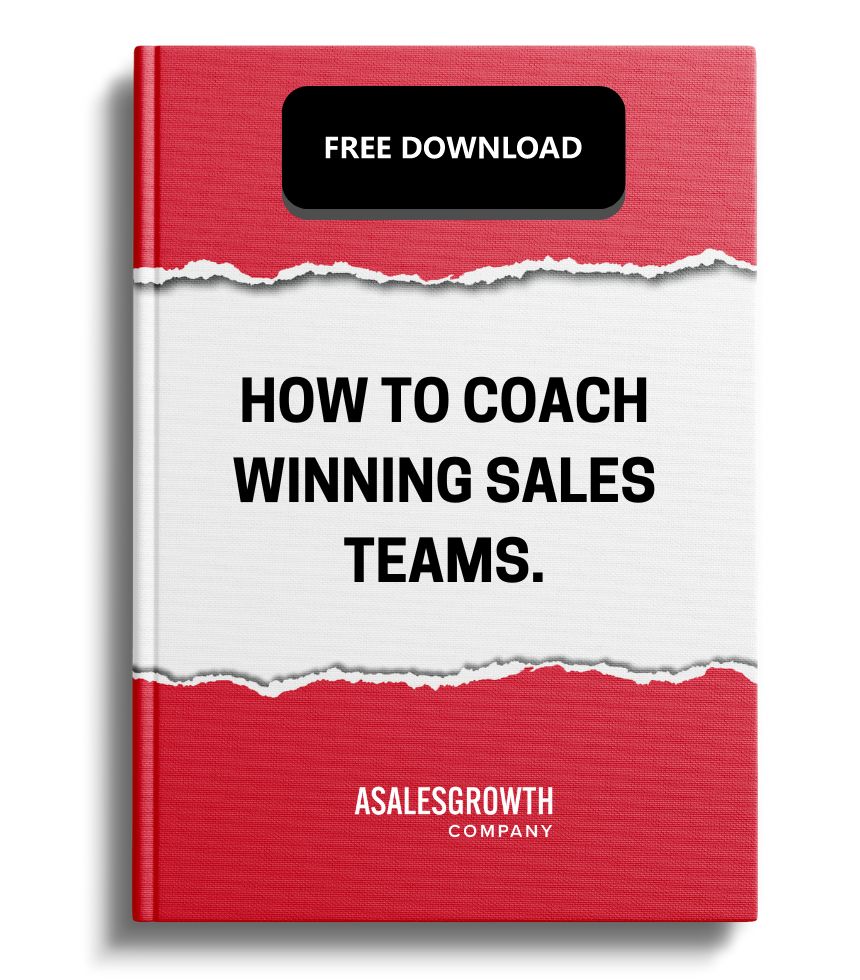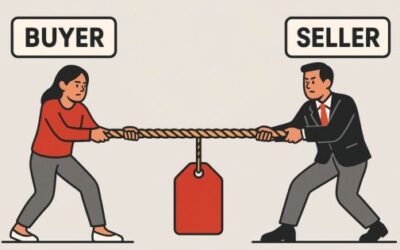There is nothing more important than sales leadership when it comes to driving revenue and creating successful sales organizations. Sales teams live and die on the strength and ability of their leaders.
While there are all type of sales leadership styles and approaches to motivating and leading teams, they can ultimately be boiled down into 5 distinct sales leader types:
- The Authoritarian Leader (The Asshole)
- The Supporter
- The Fixer
- The Enabler
- The “Ah, You Can Do It”
Each of these sales leadership styles brings unique qualities to an organization, shaping the culture, performance, and overall success of the sales team. Let’s explore these five leadership styles, examining their characteristics, strengths, and potential drawbacks.
What 1,200 B2B Buyers Expect (and Hate) From Salespeople
5 Sales Leadership Styles
Authoritarian Leader: The “Asshole”
The first sales leadership style is what we’ll diplomatically call the Authoritarian Leader, though they might also be referred to as “The Asshole.” This type of sales leader manages strictly through fear and numbers. Think Alec Baldwin from Glengarry Glen Ross – a hard driving, uncompromising figure who believes in survival of the fittest.
Key Characteristics:
Numbers-Driven: If you don’t make your number, you’re gone – no ifs, ands, or buts. The Authoritarian is solely focused on results, often at the expense of everything else.
Minimal Coaching: There is almost NO coaching in an Authoritarian’s sales organization. To them, coaching is a waste of time and gets in the way. Sellers should come prepared and take care of themselves.
Limited Support: While there might be a modicum of support, the Authoritarian determines what the team needs. They are resistant to feedback, seeing it as excuses for not making quota or closing.
Highly Competitive Environment: It’s not uncommon to see contents running. The organization is hierarchical and contentious, with top salespeople treated like gods and given special privileges. Meanwhile, underperforming sales reps are mocked and given short ropes.
Challenges with the Authoritarian leadership style:
High turnover: If turnover rates starts creeping up, there may be an authoritarian leader in your ranks. The intense pressure and fear-based management often lead to employees looking for opportunities elsewhere.
Inconsistent performance: Numbers bounce from high to low and back again. The volatility makes it difficult to predict and manage long-term performance.
Short-term focus: The strict focus on numbers can lead to short-term thinking, sacrificing customer relationships and sustainable growth patterns.
The authoritarian leadership style can result:
- Low morale, except among top performers
- High turnover rates
- Constantly fluctuating performance
- Challenging and often unfulfilling work environments
It’s worth noting this leadership style seems to be falling out of favor in modern sales organizations. While they may drive short-term results, the long-term costs to morale, retention, and reputation can hurt an organization for years.
The Empathetic Leader: The Supporter
The second sales leadership style is the Supporter. This type of sales leader is the player’s coach, well-liked by their teams for their empathetic and supportive approach to sales leadership.
Key Characteristics:
Team advocacy: Supporters are excellent advocates for the sales team and almost always will take their side. They can be seen arguing cross-functionally when sales isn’t getting the love it should, needs more budget, or is getting the blame for failing revenue (whether it’s their fault or not).
Constant support: They are constantly looking for way to give the team what they need, from new sales collateral to product support. There is very little the Supporter wont do for their team.
Empathy-driven: Supporter are very empathetic and supportive of their teams. They believe their job is to support the team with what it needs to be successful.
This leadership style still comes with some challenges:
Conflict avoidance: Supporters don’t challenge their teams as much as they perhaps should. They are slow to call out the elephant in the room if it means upsetting the applecart.
Difficulty with accountability: While supporters don’t accept poor performance, they struggles with handling problems head on. They find discipling or pushing back difficult.
Limited Coaching ability: Supporters are rarely very good coaches as they struggle to identify and call out weaknesses and areas of development.
The supporter leadership style leads to:
- Fun and positive work environments
- Strong team morale and loyalty to the leader
- Potential for problems to fester longer than they should
- Slower correction of issues when things start to veer off track
Organizations under a Supporter Leader are generally enjoyable to work in, as the leader constantly focuses on the positive. However, this approach can allow problems to bubble longer than they should and does little to address the weaknesses of the team.
The Supporter’s approach creates a positive team atmosphere, however, it’s important to balance support with accountability.
The Problem-Solving Leader: The Fixer
The third sales leadership style is the fixer. This type of sales leader shares some similarities with the Supporter in terms of popularity with their team and being an excellent advocate. However, the Fixer’s approach is distinctly different in its reactivity and problem-solving focus.
Key characteristics:
Reactive approach: Fixers do little on the front end. They are not proactive but instead spend most of their time and effort fixing what a salesperson has broken or where the organization has spring a leak.
Crisis management: If a big deal has been lost or is about to be, the Fixer will jump in and in most cases can and will save it.
Performance turnaround: When the sales organization has been missing it’s numbers and the CEO is getting restless with performance, the Fixer will enter “fix it” mode and turn things around.
Problem-solving: Fixers are excellent problem solvers. They can see the connections, what is broken, and usually knows what it takes to fix it.
However, this leadership styles comes with some challenges:
Lack of planning: Fixers are not good planners and don’t have great vision
Superhero complex: Fixers like to play the superhero role, which makes them popular with the team but creates a dependency complex.
Reactive rather than proactive: Accountability and ownership suffer as the fixer plugs holes but never searches for the reason issues keep arising.
The impacts of this leadership style:
- Problem don’t persist, as the Fixer addresses them quickly
- Teams become dependent on this person to solve problems
- Progress can be made, but it’s made through repair and reaction and not through planning and vision
- Organizations lack long-term strategy
In these organizations, teams know if things get ugly or something goes sideways, it’ll be taken care of. While the Fixer’s ability to solve problems and turn challenging situations around is valuable, it’s important to consider the long-term implications of this reactive approach.
The Growth-Focused Leader: The Enabler
The fourth sales leadership style is the Enabler. This type of sales leader isn’t always the most popular with the team, but can be extremely liked and appreciate by some and disliked by others. They Enabler’s approach is centered on empowering team members to create their own success (or failure).
Key characteristics:
Proactive support: Like Supporters, Enablers provide tremendous support for their team. They give the team all the tools they need to be successful.
Clear expectations: Enablers have excellent vision and are good at setting expectations. They try to avoid problems by setting clear expectations of what’s required of each individual and the team as a whole.
Strong coaching: Enablers are excellent coaches. They see coaching as the most critical aspect of their job and understand that they can’t do it all themselves.
Accountability focused: Enablers expect their team to understand their strengths and weaknesses and constantly be working on them.
Like the rest, Enablers also aren’t perfect:
Potentially unpopular: For people who struggle with being challenged or don’t like to be held accountable, Enablers can be difficult to work for.
Direct Approach: Enablers are quick to challenge an approach, behaviors, or issues that are affecting a salesperson or sales leader. They call out the elephant in the room.
Impacts of this leadership style on organizations:
- People are developed and problems are often averted
- Creativity is fostered and accountability flourishes
- Organizations tend to grow and improve over time
- High-performers who like to be challenged often thrive
In Enabler organizations, the leader builds highly effective teams that are capable of getting things done without constant intervention. They are proactive and prefer to avoid problems than fixing them after the happen.
For those who like to be challenged, embrace honesty, openness, and accountability, the Enabler is a dream leader. Under Enablers, people are developed, problems are averted, creativity is fostered, accountability flourishes, and organizations grow.
The Hands-Off Leader: The “Ah, You Can Do It”
The final sales leadership style is the “Ah, You Can Do It (AYCDI)”. This type of sales leader is a rare breed, but it does happen. The AYCDI leader has a ton of faith in their team, though it’s often blind faith.
Key Characteristics:
Minimal Support: The AYCDI provides almost no support and offers little guidance.
Extreme autonomy: They see salespeople as independent businesses and just set them free to go figure it out. The AYCDI gives their team autonomy, perhaps too much.
Hands-off approach: They look for their teams to come up with their own strategies, tools, ideas, and support.
Reactive coaching: The AYCDI can be great coaches, but they will rarely if ever be proactive coaches. They administer coaching if approached.
Challenges with the AYCDI leadership style:
Lack of structure: The AYCDI typically comes with very little structure which often creates a free-for-fall environment with Darwinian underpinnings.
Minimal guidance: They believe they should be hands-off and provide their team with the “space” to be successful. Unfortunately, this means very little support.
Potential for chaos: Problems and issues are addressed as they arise, with very little proactive management.
In AYCDI organizations, the leader sees their role more as a referee. If approached with a problem, they will make a ruling and move on. They don’t want to interfere with team processes.
This style can be rewarding for self-starters and lone wolf types who thrive on independence. However, it can lead to inconsistent performance and not be enough support for team members who need guidance.
Comparing Sales Leadership Styles
Now that we’ve explored all five distinct sales leadership styles, it’s important to compare them and understand how each might impact a sales organization. Each style has its own merits (well, except maybe the Asshole), the effectiveness of an approach can vary depending on the team.
Great sales leaders may incorporate elements from multiple styles, adapting their approach based on the needs of their team and organization. For example, a leader who primarily identifies as an Enabler may step into a Fixer when a crisis demands it.
In closing, it’s important to remember that there’s no one perfect sales leadership style. The best one is the one that aligns with your strengths, the needs of the team, and drives results for the organization. Find the balance, be willing to adapt, and grow as a leader.



0 Comments